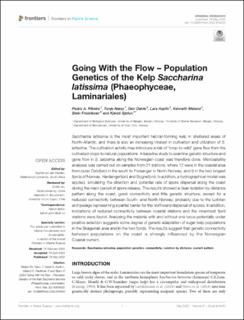| dc.contributor.author | Ribeiro, Pedro A | |
| dc.contributor.author | Næss, Tonje | |
| dc.contributor.author | Dahle, Geir | |
| dc.contributor.author | Asplin, Lars | |
| dc.contributor.author | Meland, Kenneth | |
| dc.contributor.author | Fredriksen, Stein | |
| dc.contributor.author | Sjøtun, Kjersti | |
| dc.date.accessioned | 2022-09-20T14:03:16Z | |
| dc.date.available | 2022-09-20T14:03:16Z | |
| dc.date.created | 2022-09-04T20:38:31Z | |
| dc.date.issued | 2022 | |
| dc.identifier.issn | 2296-7745 | |
| dc.identifier.uri | https://hdl.handle.net/11250/3019248 | |
| dc.description.abstract | Saccharina latissima is the most important habitat-forming kelp in sheltered areas of North-Atlantic, and there is also an increasing interest in cultivation and utilization of S. latissima. The cultivation activity may introduce a risk of “crop-to-wild” gene flow from the cultivated crops to natural populations. A baseline study to examine genetic structure and gene flow in S. latissima along the Norwegian coast was therefore done. Microsatellite analyses was carried out on samples from 21 stations, where 12 were in the coastal area from outer Oslofjord in the south to Porsanger in North-Norway, and 9 in the two longest fjords of Norway, Hardangerfjord and Sognefjord. In addition, a hydrographical model was applied, simulating the direction and potential rate of spore dispersal along the coast during the main period of spore release. The results showed a clear isolation by distance pattern along the coast, good connectivity and little genetic structure, except for a reduced connectivity between South- and North-Norway, probably due to the Lofoten archipelago representing a partial barrier for the northward dispersal of spores. In addition, indications of reduced connectivity between coastal stations and the innermost fjord stations were found. Analysing the material with and without one locus potentially under positive selection suggests some degree of genetic adaptation of sugar kelp populations in the Skagerrak area and in the two fjords. The results suggest that genetic connectivity between populations on the coast is strongly influenced by the Norwegian Coastal current. | en_US |
| dc.language.iso | eng | en_US |
| dc.publisher | Frontiers | en_US |
| dc.rights | Navngivelse 4.0 Internasjonal | * |
| dc.rights.uri | http://creativecommons.org/licenses/by/4.0/deed.no | * |
| dc.title | Going With the Flow – Population Genetics of the Kelp Saccharina latissima (Phaeophyceae, Laminariales) | en_US |
| dc.type | Journal article | en_US |
| dc.type | Peer reviewed | en_US |
| dc.description.version | publishedVersion | en_US |
| dc.rights.holder | Copyright 2022 the authors | en_US |
| dc.source.articlenumber | 876420 | en_US |
| cristin.ispublished | true | |
| cristin.fulltext | original | |
| cristin.qualitycode | 1 | |
| dc.identifier.doi | 10.3389/fmars.2022.876420 | |
| dc.identifier.cristin | 2048641 | |
| dc.source.journal | Frontiers in Marine Science | en_US |
| dc.relation.project | Norges forskningsråd: 254883 | en_US |
| dc.identifier.citation | Frontiers in Marine Science. 2022, 9, 876420. | en_US |
| dc.source.volume | 9 | en_US |

